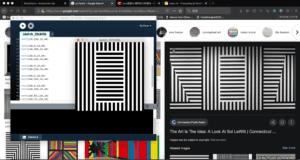The in-recitation exercise:
A rough frame for Snake games:
float bodyX[] = new float[900]; float bodyY[] = new float[900]; int n = 90; int tX = int(random(30)); int tY = int(random(30)); boolean ch = true; void setup(){ size(600,600); /* for(int x = 20; x < 600 ; x+=20){ line(x,0,x,600); line(0,x,600,x); } */ for(int i = 0; i < n ; i++){ bodyX[i] = i; bodyY[i] = 0; } ch = true; while (ch) { ch = false; for(int i = 0; i < n ; i++){ if (bodyX[i] == tX && bodyY[i] == tY){ ch = true; break; } } tX = int(random(30)); tY = int(random(30)); } } void draw(){ background(255); noStroke(); fill(255,0,0); rect(tX*20,tY*20,20,20,9); if (key == CODED){ if (keyCode == UP){ bodyX[n] = bodyX[n-1]; bodyY[n] = bodyY[n-1]-1; } else if (keyCode == DOWN){ bodyX[n] = bodyX[n-1]; bodyY[n] = bodyY[n-1]+1; } else if (keyCode == LEFT){ bodyX[n] = bodyX[n-1]-1; bodyY[n] = bodyY[n-1]; } else if (keyCode == RIGHT){ bodyX[n] = bodyX[n-1]+1; bodyY[n] = bodyY[n-1]; } } fill(0); for(int i = 0; i < n ; i++){ rect(bodyX[i]*20,bodyY[i]*20,20,20,9); bodyX[i] = bodyX[i+1]; bodyY[i] = bodyY[i+1]; } }
And it works like this:
https://drive.google.com/open?id=1m3duuuMUULfbwqRqAzpWoxTD67Bs1rKk
The homework
float speed = 8;
float r = 50;
float x = 300;
float y = 300;
float js = 5;
float i = 0;
float j = 40;
void setup(){
size(600,600);
colorMode(HSB, 100);
}
void draw(){
background(0,0,100);
strokeWeight(20);
ellipse(x,y,r,r);
if ( r < 40 || r >= 400) {
speed = -speed;
}
r += speed;
stroke(i, j, 80);
j += js;
if ((j == 100)||(j< 40)) {
js = -js;
j += js;
i += 5;
}
if (keyPressed){
if (keyCode == UP){
y -= 5;
}
else if (keyCode == DOWN){
y += 5;
}
else if (keyCode == LEFT){
x -= 5;
}
else if (keyCode == RIGHT){
x += 5;
}
}
}
And it works like this:
https://drive.google.com/open?id=1uisZ76edhzquj-BM_xKI6QMYSqII03oA
During the coding, I found how to draw a dynamic multi-element image and make it move. Like I do in the in-class exercise, I made a snake and using the keyboard to make it move. One trivial detail that particularly surprises me is that we need to use (key == CODED) to determine whether something WAS PRESSED and (keyPressed) to determine whether something IS PRESSED. There is a huge difference between that. Something like a snake, which keeps moving should use the former one to get the moving signal; while something like a circle, which only moves when instructions are given, needs the application of the latter one. That’s something very interesting about these functions that I found.


